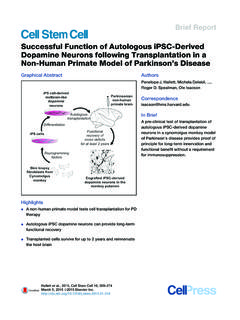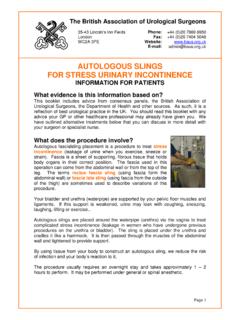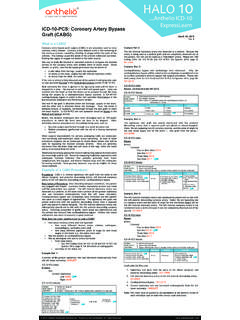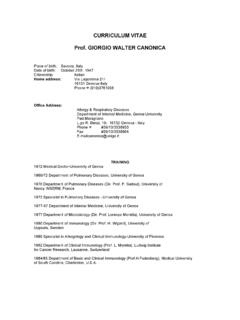Transcription of ChondroCelect, Characterised viable autologous …
1 1 ANNEX I SUMMARY OF PRODUCT CHARACTERISTICS Medicinal product no longer authorised2 1. NAME OF THE MEDICINAL PRODUCT ChondroCelect 10,000 cells/microlitre implantation suspension 2. QUALITATIVE AND QUANTITATIVE COMPOSITION General description Characterised viable autologous cartilage cells expanded ex vivo expressing specific marker proteins. Qualitative and quantitative composition Each vial of product contains 4 million autologous human cartilage cells in ml cell suspension, corresponding to a concentration of 10,000 cells/microlitre. For the full list of excipients, see section 3. PHARMACEUTICAL FORM Implantation suspension Before re-suspension the cells are settled to the bottom of the container forming an off-white layer and the excipient is a clear colourless liquid. 4. CLINICAL PARTICULARS Therapeutic indications Repair of single symptomatic cartilage defects of the femoral condyle of the knee (International Cartilage Repair Society [ICRS] grade III or IV) in adults.
2 Concomitant asymptomatic cartilage lesions (ICRS grade I or II) might be present. Demonstration of efficacy is based on a randomised controlled trial evaluating the efficacy of Chondrocelect in patients with lesions between 1- 5cm . Posology and method of administration ChondroCelect must be administered by an appropriately qualified surgeon and is restricted to hospital use only. ChondroCelect is solely intended for autologous use and should be administered in conjunction with debridement (preparation of the defect bed), a physical seal of the lesion (placement of a biological membrane, preferentially a collagen membrane) and rehabilitation. Posology The amount of cells to be administered is dependent on the size (surface in cm ) of the cartilage defect. Each product contains an individual treatment dose with sufficient number of cells to treat the pre-defined lesion size, as measured at biopsy procurement.
3 The recommended dose of ChondroCelect is to 1 million cells/cm , corresponding with 80 to 100 microlitre of product/cm of defect. Elderly population The use of ChondroCelect has not been studied in this age group. Paediatric population The safety and efficacy in children and adolescents (aged less than 18) have not been established. ChondroCelect is therefore not recommended for use in children and adolescents below 18 years. Medicinal product no longer authorised3 Method of administration For implantation. ChondroCelect is intended solely for use in autologous cartilage repair and is administered to patients in an autologous Chondrocyte Implantation procedure (ACI). Implantation of ChondroCelect is to be performed during arthrotomy under sterile conditions and requires both preparation of the defect bed and a seal (biological membrane) to secure the implant.
4 Complete joint haemostasis must be achieved prior to membrane fixation and cell implantation. During the ACI procedure it is important to ensure that a good, direct contact of the implanted cells with the defect bed is obtained as such contact is of paramount importance for optimal tissue regeneration. In clinical studies with ChondroCelect a periosteal flap was used as a biological membrane. Scientific publications have shown that commercially available collagen membranes can be used as an alternative to the periost in ACI procedures. However, ChondroCelect has not been evaluated in combination with collagen membranes in clinical studies, although a commercially available collagen membrane has been used in patients treated with ChondroCelect under compassionate use. The safety data obtained in these patients do not indicate a particular safety concern, and confirm a lower incidence of hypertrophy as suggested by scientific literature on the use of collagen membranes versus periost.
5 A technical variant of the ACI procedure is the cell seeding method, whereby the cells are seeded onto a collagen membrane prior to implantation. In this technique, a good fixation using stitches on the edges of the collagen membrane is required, in order to assure a direct contact of the implanted cells with the defect bed. Using fibrin glue only, instead of stitches, to secure the implant is not recommended. The implantation should be followed by an appropriate rehabilitation schedule for approximately one year, as recommended by the physician (see section ). Full technical details on the procedures associated with this implantation technique are provided in the ChondroCelect user manual. For information on preparation and handling of ChondroCelect, please refer to section Contraindications Hypersensitivity to any of the excipients listed in section , or to bovine serum.
6 ChondroCelect must not be used in case of advanced osteoarthritis of the knee. Patients with femoral epiphyseal growth plate that is not fully closed Special warnings and precautions for use General ChondroCelect is an autologous product and should under no circumstances be administered to other patients. Patients with acute or recent history of bone or joint infections should be temporary deferred until documented recovery. Precautions for use Concomitant knee problems like early osteoarthritis, osteochondritis dissecans (OCD), instability of the knee, cartilage lesions at other locations than the femoral condyle, lesions of knee ligaments or of the meniscus, varus or valgus malalignment (abnormal weight distribution in the knee), and inflammatory joint disease are potential complicating factors. In the pivotal study of ChondroCelect, patients with these comorbidities of the knee were excluded from treatment.
7 Where possible, concomitant knee problems should be corrected prior to or at the latest at the time of ChondroCelect implantation. In the pivotal study there was no influence of Body Mass Index (BMI) on outcome but bibliographic data shows that a BMI over 30 may adversely affect the success of the procedure. Medicinal product no longer authorised4 Rehabilitation Upon implantation, the patient should follow an appropriate rehabilitation schedule and physical activity should be resumed as recommended by the physician. Depending on the location, the size of the lesion and the patient s profile, appropriate rehabilitation instructions have been developed. Too early and vigorous activity may compromise the grafting and the durability of clinical benefit from ChondroCelect. Therefore the treated knee should be protected according to the recommendations as outlined in the appropriate rehabilitation schedule, to avoid early damage which might lead to graft failure.
8 Details and information on the appropriate rehabilitation schedule is provided in the ChondroCelect user manual. Cases in which ChondroCelect cannot be supplied In some cases it can be possible that the source chondrocytes of the patient are not expandable or that the release criteria are not met, due to poor biopsy quality, patient characteristics, or manufacturing failure. Therefore it can occur that ChondroCelect cannot be delivered. The surgeon will be informed as early in the process as possible, and should hence select an alternative treatment for the patient concerned. Interaction with other medicinal products and other forms of interaction Fibrin glues are routinely used in ACI procedures to seal the outside margins and to improve the water-tightness of the compartment of the biological membrane used to cover the defect.
9 The use of fibrin glue inside the cartilage defect bed is not recommended as this may result in a significantly poorer outcome (see section ). Fibrin sealant products differ significantly in their quantitative and qualitative composition. In vitro interaction studies were performed with a commercially available fibrin glue containing aprotinin (a fibrinolysis inhibitor of bovine origin). These studies have demonstrated that this type of fibrin sealant can be safely used with ChondroCelect. No interaction studies with any other type of fibrin glues were performed. However, the concomitant use of another type of fibrin glue with a synthetic fibrinolysis inhibitor (tranexamic acid) in the pivotal clinical trial did not reveal any safety signal. Pain relief medicinal products should be used according to the recommendations of the responsible surgeon.
10 Fertility, pregnancy and lactation Pregnancy Limited clinical data on exposed pregnancies are available. Conventional reproductive and developmental toxicity studies are not considered relevant, given the nature and the intended clinical use of the autologous cell therapy product. As ChondroCelect is used to repair a cartilage defect of the knee and is implanted with the ACI procedure using open-knee surgery, it is not recommended during pregnancy. Breast-feeding There are no data on the use of ChondroCelect during breast-feeding. Given the local nature of ChondroCelect adverse reactions on the nursing infant are not anticipated. A decision should be made whether to discontinue breast-feeding taking into account the potential benefits of the treatment for the woman and the potential risk to the infant. Fertility There are no data on possible effects of ChondroCelect treatment on fertility.















